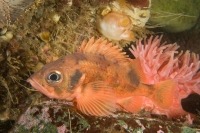
(Photo: Andrew J. Martinez)
Acadian Redfish
Sebastes fasciatus
Spiny-rayed fish with a distinctive flame-red colour. The subspecies S. fasciatus kellyi can be dark green to black. They have a bony protrusion on their lower jaw, large eyes, and a fan of spines that radiate out from their gill cover. They can reach lengths of 45 centimetres.
Authority
Storer, 1854
Classification Details
Phylum: Chordata (chordates); Subphylum: Vertebrata (vertebrates); Class: Actinopterygii (ray-finned fishes).
Habitat
A demersal species that is found close to rock or clay seabeds. Often found under overhangs and in caves. Found from depths of a few metres to 592 metres, though typically from 150 metres to 300 metres. The subspecies S. fasciatus kellyi is found around the shallow coastal waters of Eastport and Deer Island. Present in the northwestern Atlantic from the Labrador Sea to the Gulf of Maine.
Diet
Predators. Remain near the bottom during the daytime but rise up to feed in the water column at night. Larvae feed on the eggs of fish and invertebrates. Young redfish eat crustaceans such as amphipods, copepods and krill. Older, larger redfish eat more fish.
Reproduction
Separate sexes. Fertilization is internal and occurs between September and December. The female carries the young until she releases them as larvae at the end of spring. A female may produce between 1 500 and 107 000 larvae depending on length. The larvae measure six to nine millimetres at birth. Redfish are very slow growing and can live for at least 75 years. The average age of reproduction is 16 to 18 years. Recruitment is highly variable, and strong year-classes are only produced every five to twelve years.
Fun Facts
Scientists consider the Atlantic population of Acadian Redfish threatened. They are very long-lived, late maturing and highly vulnerable to mortality from human activities. Abundance of mature individuals declined 99% over about two generations. Measures to protect them include controlling targeted fishing. Fishermen have reduced the amount they catch as bycatch in shrimp trawls by using Nordman grates.
Acadian redfish are very similar in appearance to the deepwater redfish (Sebastes mentella) and the golden redfish (Sebastes norvegicus). Scientists thought that all three were a single species and only recognized them as distinct in the 1950s and 1960s. This makes fisheries management difficult. It is hard to distinguish the species on surveys and to get species-level population information.
References
Barsukov VV (1968) The systematic relationship of redfishes of the genus Sebastes of the Northwest Atlantic Ocean. Doklady Akademii Nauk SSSR 183: 479–482.
COSEWIC (2010) COSEWIC assessment and status report on the Deepwater Redfish/Acadian redfish complex Sebastes mentella and Sebastes fasciatus, in Canada. Committee on the Status of Endangered Wildlife in Canada. Ottowa x + 80 pp (https://www.canada.ca/en/environment-climate-change/services/species-risk-public-registry.html).
Litvinenko NI (1979) Sebastes fasciatus kellyi (Scorpaenidae) from coastal waters off Eastport, Maine, U.S.A. Voprosy Ikhtiol. V. 19 (3): 387-401. (in Russian). Translated to English in Journal of Ichthyology 19, 1–14.
Martinez AJ (2019) Marine life north Atlantic. Digital application http://marinelifeofthenorthatlantic.com/ Accessed online 20 January 2020.
Scott WB and Scott MG (1988) Atlantic fishes of Canada. Canadian Bulletin of Fisheries and Aquatic Sciences 219, 731p.
Templeman W and Sandeman EJ (1957) Two varieties of redfish in the Newfoundland area. Fisheries Research Board of Canada. Progress reports of the Atlantic Coast Stations 66: 20–22.


